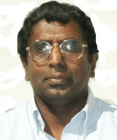- Speaker
- Prof. Gayanath Fernando
- University of Connecticut, USA
- Abstract
Organic crystals are comprised of carbon-based molecules that crystallize in well defined lattice structures. Any theoretical modeling of such materials is bound to have challenges related to distinct energy scales inter- and intra-molecular electron hopping, and strongly localized and correlated electrons with indications of unconventional superconductivity. Such organic materials have the advantage of being soft and conducive to pressure and offer flexibility in realizing a broad variety of options for functionlization. We have examined the charge transfer salts (BEDT-TTF)2X3 (X = F, Cl, Br, I), in various phases, identifying α-(BEDT-TTF)2F3 to be a Dirac-type-II semi-metal under ambient pressure. The decreasing size of the anion atom corresponds to applying chemical strain which increases tremendously with F substitution. In the case of the phase, the formation of over-tilted Dirac-type-II nodes within the quasi two-dimensional Brillouin zone can be found while in the non-symmorphic-phase, there are indications of a topologically protected node. Some of these quasi two-dimensional organic materials have been identified as candidates for odd-frequency superconductivity. A brief discussion of our ongoing efforts in this regard as well as some intriguing results from an exact study of Hubbard clusters will also be presented at this talk.
- About the Speaker
Gayanath Fernando is a Professor of Physics at the University of Connecticut, Storrs, Connecticut, USA. He received his first degree from the University of Colombo in Sri Lanka having graduated with first class honors in Mathematics. During 1981-1985, he was a graduate student at Cornell University in Ithaca, NY, USA and obtained his MS and PhD degrees under the supervision of Prof. John Wilkins. Later, he worked as a research assistant at Brookhaven National Laboratory in their condensed matter theory group, before joining the University of Connecticut. His work over the past few decades spans a wide variety of problems in theoretical condensed matter; developing accurate theoretical and computational techniques based on DFT, MD, QMC, ED, and applying them to study bulk and surface electronic and magnetic structure, chemisorption, stability of crystal structures, elastic properties, cohesion, alloy phase diagrams, point defects in alloys, spectroscopic properties of transition metal systems, self diffusion in simple liquid metals and spintronics. Currently he is searching for Dirac-like properties in organic materials, their topological properties and related superconductivity. Some of his more recent work on exact many body calculations of Hubbard clusters has uncovered some exotic properties of strongly correlated nanoclusters. He has also authored a book on "Metallic Multilayers", published by Elsevier (Amsterdam) in 2008.
- Date&Time
- 2018-09-11 11:00 AM
- Location
- Room: A303 Meeting Room




